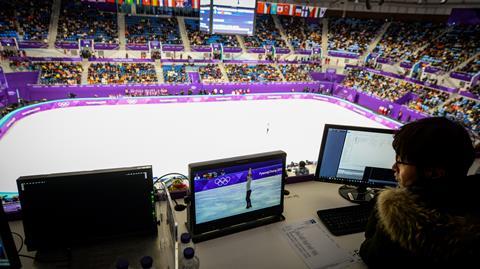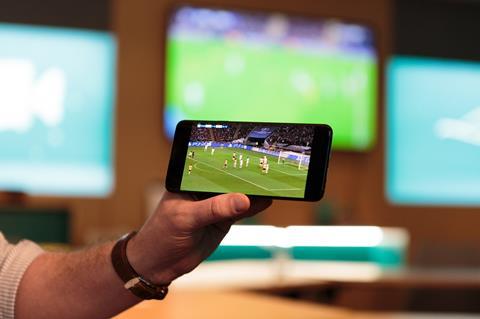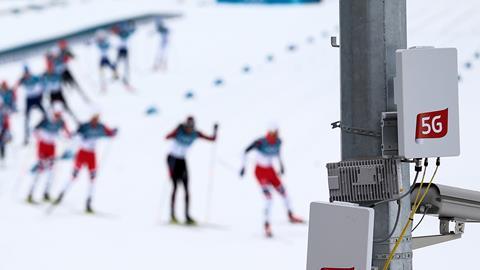The potential for 5G to revolutionise the media and entertainment industries is now being tested by sports producers and broadcasters.
A critical milestone on the road to 5G was achieved last month - official approval of standalone specifications by international telecoms standards organisation 3GPP.
Effectively, the agreement means the industry is now in the final leg of the race to roll out 5G commercially, allowing broadband-equivalent download speeds over mobile networks.

Underscoring the mobile industry’s excitement about the huge revenue generating potential of this fifth and final generation cellular network (so good is 5G there won’t be a 6G), 3GPP chair Georg Mayer said: “Two years ago, 5G was seen as a vision or even just a hype — with the closing of [the new specification] 3GPP has made 5G a reality within a very short time.”
The agreed specifications allow chip, device and network developers to launch 5G products which are not tied to legacy 4G technologies.
They will provide a platform for the launch of 5G networks, which in turn is expected to drive the take up of the cellular Internet of Things [IoT].
Nokia’s EVP and Head of Business Area Networks Fredrik Jejdling believes the technology promises “new capabilities that will impact people’s lives and transform industries.”
That’s because 5G networks will be able to handle more data and connect more devices simultaneously and do this all at much faster speeds than is possible using existing technology.
5G will connect the Internet of Things, help to transform cities into smart cities and drive new modes of industry, sometimes breathlessly dubbed the fourth industrial revolution.
The technology will also play a pivotal role in delivering new immersive media applications, like ubiquitous UHD HDR streams and virtual reality.
Coming to a live event near you
The first impact of 5G in the broadcast industry is likely to be felt in live events.
The latest demonstration of its potential was during the World Cup, in a match between Morocco and Iran. Feeds from cameras at St Petersburg’s Kresovsky Stadium were routed 600 km over a 5G connection to Moscow. There, viewers in a designated ‘5G zone’, were able to watch the game in VR, switching between camera angles on the fly.
The 5G platform has long been touted as a potential key link in the 4K video delivery chain thanks to its multi-gigabit speeds and latencies as low as a millisecond.
Fox Sports put this to the test for camera contribution during last week’s U.S. Open Championship, in a collaboration with Fox Innovation Labs, Intel, Ericsson, and AT&T. Ericsson provided the 5G radios, baseband and 4K video encoder and decoder; Intel supplied its 5G Mobile Trial Platform, a device capable of transmitting 1.6 Gbps and 5G to IP translation, while AT&T set up a temporary network connection to deliver the 4K shots from the seventh hole.
An earlier proof of concept was made at the Winter Olympics in South Korea, in February. 4K cameras were fitted to the front of Olympic bobsleighs to offer a bullet’s eye view which was cut into the live production (output in HD). The Olympic broadcasting organisation expressed keen interest in exploring the use of 5G further with a view to eventually replacing traditional contribution solutions over RF.
These limited trials are just the beginning. It won’t be long before coverage of an entire tournament is routed over 5G to be remotely produced.
While broadcasters can use the existing 4G mobile network to contribute live signals today (mainly for store and forward), the bandwidth tends to be congested and the signal interrupted. By contrast, 5G provides a guaranteed bit rate and latency.
“The ability to perform network slicing with 5G means that wireless contribution becomes a viable reality,” explains BT Director of Mobile Strategy Matt Stagg. “It means we can look at replacing the satellite truck with 5G connectivity and move all production back to a central hub. This has massive operational cost savings.”

Stagg’s vision for a commercial 5G sports production product is one where a producer could decide how much bandwidth and latency they needed at a certain time, duration and location.
“We are a very long way away from that happening but that’s the current model for satellite or fibre booking and one that 5G will replace,” he asserts. “With 5G, everything can be done remotely using 5G cameras. 5G guarantees broadcast grade delivery.”
He says BT Sport is looking at what 5G can do for its own sports coverage, its wider media and broadcasting business and what it could mean for other broadcasters. It has “glass to glass” tests in the works.
ITN Chief Technology Officer Bevan Gibson agrees with 5G’s potential.
“Network segmentation and the ability to lock bandwidth down to a particular user will be much more common place as we get into ultra-local and ultra-high speed networks. You will be able to carve off a gig or two for particular use. So, a broadcaster at a stadium could access a slice of the network and wouldn’t have to put in costly infrastructure.”
Weighing up risks
However, Gibson is more cautious in recommending the technology’s immediate benefits.
“It may be fine for Tier 2 sports where 5G could make coverage more cost-effective than before but for world class events my concern would be network contention,” he says. “If 5G connects hundreds of thousands of other objects from phones to gas metres will the bit of spectrum you have allocated work? Rights holders and producers would want certainty.”
Gibson believes 5G could be of more use in the short term for broadcasting from unplanned events, such as a natural disaster or a terror incident.
Likewise, production company Sunset + Vine - one of whose main clients is BT Sport - is less gung-ho than some about 5G’s contribution for top end sports distribution.
“Certainly, 5G would provide a less expensive back-up path [than fibre/satellite] but I wouldn’t be comfortable relying on it as the only contribution circuit for the main programme feed,” says Sunset + Vine Director of Technical Operations Mark Dennis.
“When clients have paid so much to cover a job then reliance on a product you don’t have 100% control over would be a worry.
“That said, 5G does open up massive possibilities for sports contracts where budgets are very restrictive. It also offers tremendous flexibility for access. Instead of putting in an expensive RF infrastructure you could put in a 5G backpack and broadcast anywhere.”
Manufacturers like LiveU and Teradek will be racing to bring out the first bonded cellular 5G live streaming solution.
Dennis adds: “Instead of the delay you have now using cellular links, you could do live two-ways from the team hotel, in the dressing room - anywhere in the world there’s a 5G connection. It will be a massive bonus for getting more colour and more stories from major events.”
“5G opens up massive possibilities for sports contracts where budgets are very restrictive. It also offers tremendous flexibility for access.” Mark Dennis, Sunset + Vine
Smart stadiums
We’ve all suffered from the inability to access the internet in a crowded environment such as a mass spectator event when the network is being drained by dozens of other people trying to do the same thing.
5G to the rescue. Nokia estimates that 5G can provide up to 40 times more capacity in a stadium than even 4.5G - opening up opportunities for fans, stadiums and service providers alike.
A pop concert for 18,000 spectators at the Mercedes-Benz Arena in Shanghai last February was streamed live in HD to users at the venue using a mobile app on their device, cutting latency to just 0.5 seconds. Technology from Nokia and Intel enabled the video to be stored locally and routed straight to attendees instead of traveling across the backhaul network.
“5G will open up multi-platform second screen experiences in the stadia,” says Dennis. “If you can get Diva [the interactive live sports streaming platform from Deltatre] working on 40,000 smartphones in a ground it will make VAR [video assistant refereeing) very interesting indeed because everyone would have access to multiple angles of a key incident.”
Another 5G trial, this time with Japanese telco KDDI and Samsung, streamed 4K video of a baseball game live to fans on 5G tablets in the Okinawa Cellular Stadium. Each video provided different angles of baseball play, athlete statistics and ballpark information.
Samsung considered the trial “a leap forward in content delivery”, offering “high-speed, high-quality content that can be viewed by many people simultaneously, in a crowded and dense venue.”
An earlier test made by Verizon at a baseball game in Minneapolis invited customers to view stereoscopic video feeds on untethered VR goggles.
This is a flavour of the experience that visitors to London’s O2 arena can expect when a 5G network opens there later this year. The network will initially be in a couple of locations, including the exclusive O2 blueroom and the venue’s store, before extending coverage across the venue by the end of 2020.

Meanwhile, BT has partnered with Nokia and Qualcomm to explore how 5G can be used to improve the streaming of sports events. The idea is to take feeds from 4K cameras at a stadium, couple them with a 5G modem and use 5G to send the camera feeds to a centralised mixing facility. The resulting mix could then be sent back to spectators in the ground – or wider afield to users at home.
BT is working to trial this scenario at various events in the UK right now.
One billion 5G connections in five years
North America will lead the global 5G charge, with all major US operators planning to roll 5G out between late 2018 and mid-2019, according to Ericsson’s latest Mobility Report.
Carriers AT&T and Verizon will have deployed in five U.S cities each by the end of 2018. Sprint, currently negotiating a $26.5 billion merger with T-Mobile, is playing catch-up.
By end of 2023, close to 50% of all mobile subscriptions in North America are forecast to be for 5G, followed by North East Asia at 34%, and Western Europe at 21%.
Europe lags behind although in October, BT-owned mobile operator EE will switch on what it claims to be the UK’s first live 5G network, in London’s Tech City. It will only be a trial.
Globally, Ericsson forecasts over one billion 5G subscriptions by the end of 2023, accounting for around 12% of all mobile subscriptions and accounting for more than 20% of mobile data traffic worldwide.
As with previous mobile access technologies, 5G is expected to be deployed first in dense urban areas with enhanced mobile broadband and fixed wireless access as the first commercial use cases. Other use cases will come from industries such as automotive, manufacturing, utilities, and healthcare.
First-generation, 5G data-only devices are expected later this year. The first commercial smartphones supporting 5G are expected early next year, while support for very high spectrum bands is expected in early to mid-2019.
Intel and Qualcomm are racing to put 5G chips into handsets, laptops and PCs. Intel for instance has a deal with Dell, HP, Lenovo, Asus, Acer and Microsoft to put its 5G modems inside a range of notebook PCs.
“We can look at replacing the satellite truck with 5G connectivity and move all production back to a central hub. This has massive operational cost savings.” Matt Stagg, BT Sport
From eSports to holography
With Telstra and Ericsson, Intel recently conducted one of the world’s first eSports professional gaming experiences over a live 5G connection on Australia’s Gold Coast.
On a 5G network, latency is considered ‘ultra-low’ at six milliseconds, compared to 20 milliseconds on 4G. This is a crucial reduction in lag for eSports, where tiny delays in responsiveness between pressing a button and getting a result can affect who wins.
Mobile carriers like Telstra believe the combination of 5G and eSports will be a key driver for generating revenue from the 250 million eSports enthusiasts expected to be playing worldwide by 2021.

“Applications today are capped by 4G speeds but the world of 5G opens everything up,” says Dennis. “We are trialing the use of 360-cameras to put fans right in the middle of the action.”
Formula 1, for example, has trialed 360-cameras on board racecars and in the driver’s cockpit, allowing viewers to switch between angles.
While interactive 360- streamed video and superfast 4K downloads are often touted as the main new media applications, BT Sport wants to look beyond this.
“If you are going to do immersive media then don’t do the same as before only slightly better,” says Stagg. “There are elements to 5G that enables us to do things we cannot have done before. Things we may not yet have thought of.”
Begin able to augment the big screen experience with replays of action with six degrees of movement is one example. “We want to put ourselves in the position of a fan unable to attend the game. What would they want to see? How close to the actual game can we get them?”
Stagg says holography is “a perfect example” of the applications BT Sport wants to explore.
“The baseline is a live event streamed to mobile in HD 1080p 60. That’s the very least our customers will expect. Beyond that anything is possible.”
Watch Telco and media shorts: Matt Stagg, BT Sport
IBC2018 The Telco & Media Innovation Forum takes place on Friday 14 September. The one-day, invitation-only event will bring together executives for a discussion on the challenges and opportunities as traditional telcos transition to digital players and broaden their offerings by adding content assets and partnerships with content providers.

























No comments yet